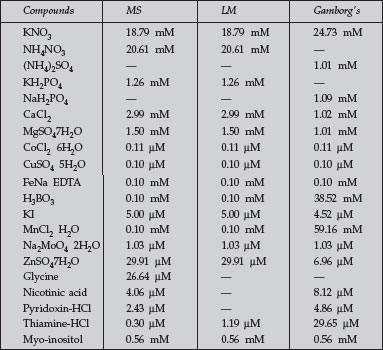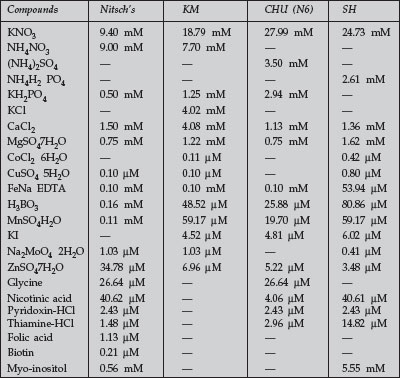Preparation of Plant Tissue Culture Media
Since the pioneer plant tissue culture studies, one of the main
objectives was
to design a proper medium that supports sufficient growth of the
explants in
a totally artificial environment. The first medium formulations used
for plant
culture work were based on experience of microorganisms. These media
contained
several distinct classes of compounds:
- Carbon source
- Organic supplements
- Inorganic salts
- Trace elements.
 |
Table 1 Composition of commonly used tissue culture media
in molar concentration |
As works on plant cell cultures progressed, attention was paid in order
to
specifically define media for an optimal growth of the variable plant
cells,
tissue,
and organs. Today, the most commonly used culture media are based on
following components:
- Macroelements—N, P, K, Ca, Mg, and S
- Microelements—Fe, Cu, Mn, Co, Mo, B, I, Zn, Cl and sometimes Al, Ni,
and Si
- Carbon source—Sucrose, glucose, fructose, or sorbitol
- Organic compounds (Vitamins)—thiamine, niacin, pyridoxine, biotin, folic
acid, ascorbic acid, tocopherol
- Myo-inositol or casein hydrolysate
- Complex organics—Coconut milk and water, yeast extract, fruit juices, or
pulps
- Plant growth regulators—Auxins, cytokinins, Gibberellins, abscisic acid
- Gelling agents—Agar, agarose, gellan gum
- Other components—MES, activated charcoal, antibiotics, fungicides.
The number of plant species that have been cultured and the different
media
used are extensive. Once the plant species to be cultured is decided
upon, a
suitable medium formulation should be selected. One of the most
successful media, is the MS medium, was devised by Murashige and Skoog
(1962),
based on the constitution of tobacco plants. The choice or formulation
of the
media basically depends on the requirements of the cultivated explant
and
species.
Media Formulation
 |
Table 2 Composition of commonly used tissue culture media in
molarconcentration |
As mentioned above, MS medium was developed for culture of tobacco
explants
and the
formulation was based on the analysis of the mineral compounds
present
in the tobacco tissue itself (Table 1). It is noted for its high salt
levels,
particularly K and N salts. LM medium (Linsmaier and Skoog, 1965) is a
revision of the MS medium, in which the organic constituents have been
modified
and
only thiamine and myo-inositol retained. White’s medium (White, 1963)
was devised for the culture of tomato roots and has lower concentrations
of
salts
than MS medium. Gamborg’s B5 medium (Gamborg et al., 1968) was
devised
for soybean callus culture and contains a much greater proportion of
nitrate compared to the ammonium. SH medium (Schenk and Hildebrandt,
1972)
was developed for callus culture of both monocotyledons and
dicotyledons.
Nitsch’s medium (Nitsch and Nitsch, 1969) was developed for another
culture.
It
contains lower salt concentrations than that of MS, but not as low as
that of
White’s
medium. KM medium (Kao and Michayluck, 1975) was designed to
grow
cells and protoplasts of Vicia at a very low cell density in liquid
media.
The
medium of Chu (N6) is defined to improve the formation, growth, and
differentiation of pollen in rice. The concentration of ammonium proved
to be
crucial
for the development of callus. Recently other media have been developed
for
specific explants and species.






